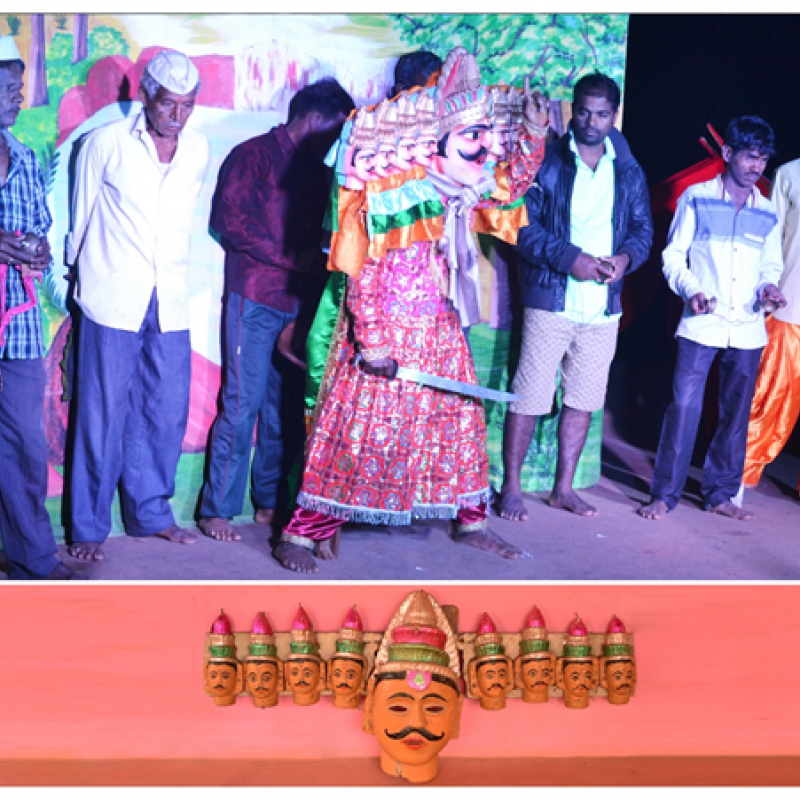Khele is one of the many performance art forms from Konkan, the western coastal belt of India along Maharashtra. Performed by the Kunbi community of central Konkan in Ratnagiri district, khele (which traces its roots to the word khel, which means both play and a dramatic performance) is a three-hour night performance that narrates mythological stories from the Puranas, Ramayana and Mahabharata.
The Kunbis are a farming community in the Konkan region which predominantly grows rice in the monsoons and other legumes and vegetables in winters and summers, depending on availability of water. The recreational activities of the Kunbis are collectively called naman aani nach (reverence and dance)—naman is another name for khele as nach is for jhakadi (duel through songs)—and are intrinsically linked with the harvesting schedules. The Kunbis till their land for rice until July, after which the farm does not require active labour and the farmers are free until Diwali. Another relatively non-laborious period for the farmers is post-harvest. It is during these times that they play jhakadi in their verandas and practise and perform khele.
Performance Rituals
Khele is a male-dominated performance art form in which young men dress up to perform the roles of good and evil, beasts and birds, and also women. The performances brighten the full moon nights of Holi Purnima as well as auspicious events such as weddings and naming ceremonies in the Konkan region. (Fig. 1) While traditionally khele was limited to mythological storytelling and narration of Konkani folk stories, it has now ventured into addressing social issues and current affairs. The performance begins late in the evening after dinner and continues to add rasa, rang and raag into the deep night.
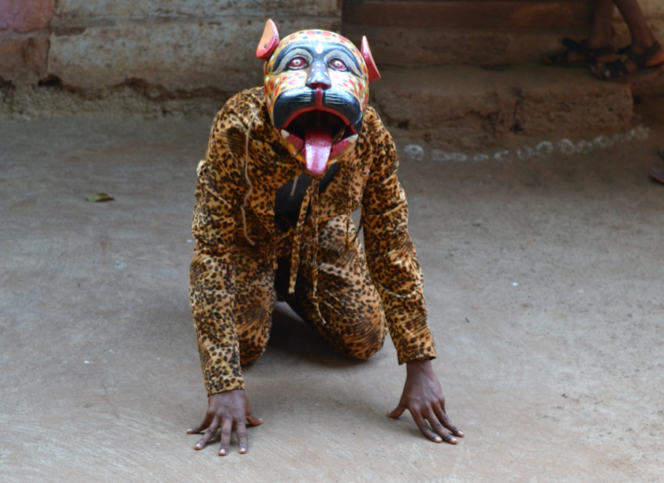
The first performance of the year is called thap. For the Kunbis, the year begins with the monsoons and is directly connected to their farm labour. The first performance can be scheduled on any auspicious day according to the Hindu almanac after Diwali. Some villages choose Dev Diwali, Dutta Jayanti, Makar Sankranti and other such special days for their first khele performance. Khele might be a full-night affair in some villages, while in others it is a small performance before the gods. However, all the performers unanimously agree that if they miss the thap, evil things happen to them and their families. The thap symbolises their reverence towards the village deity to whom they dedicate the first performance or a part of it. An hour before the performance, some actors dress up and go to the temple of the village deity. They pray to the god or goddess, perform a bhajan and return with blessings to the sahan (the community hall where the act is performed).
For its performers, khele’s artistic significance goes hand in hand with its utility as a source of income. In Maharashtra, a new job is offered or accepted with an exchange of supari (betel nut). This is a practice also followed for khele performances, where patrons offer supari to troupes to perform at weddings or naming ceremonies organised at their homes. These performances are often customised to serve the needs of the audience: masks and characters from the Puranas are adapted to even fit the stereotypical roles of Marathi in-laws such as navarya chi attu (groom’s aunt). (Fig. 2)
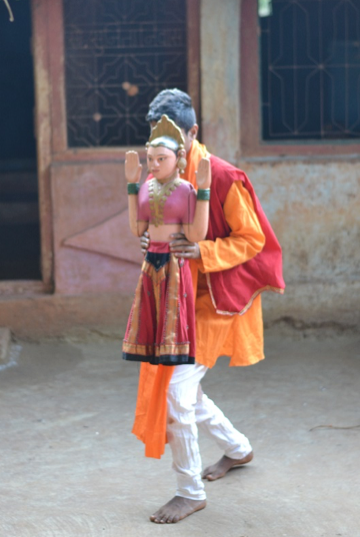
There was a time when khele troupes would perform in exchange of coconut, rice and new clothes, but for decades now they have shifted to monetary payments. A khele troupe currently charges Rs 25,000–4,00,000 for night performances, depending on the grandeur of the act, and the location of the event as well as the popularity of the troupe and their script.
Organisational Structure of a Khele Troupe
A khele troupe is led by its director. It is made up of prepubescent boys; the youngest member can be six years old while there is no upper or retirement age for the older members. Usually, the younger boys play the role of women. The boys acting as the gavalan (female cowherds) receive special training, which includes feminine dressing and manner of walking and talking. They are teased by other actors to add grace to their walk and taught to seduce with their eyes. Every khele troupe invests a lot of time in their gavalan’s makeup, costume and jewellery. The youngest members of the khele troupe don the role of the child versions of Ganesha and Krishna. (Fig. 3)
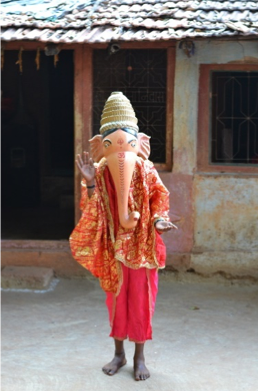
Apart from the actors, a khele troupe includes musicians, a tailor, a carpenter and his apprentice. The tailor makes the costumes and alters them to fit various actors when necessary. The carpenter carves the masks from pangara (Indian coral tree) wood and also makes other props such as swords, throne, tutari (a type of trumpet) and various seats of gods (lotus, Himalaya mountains, or anantshesha nag as in the case of Vishnu). (Fig. 4)
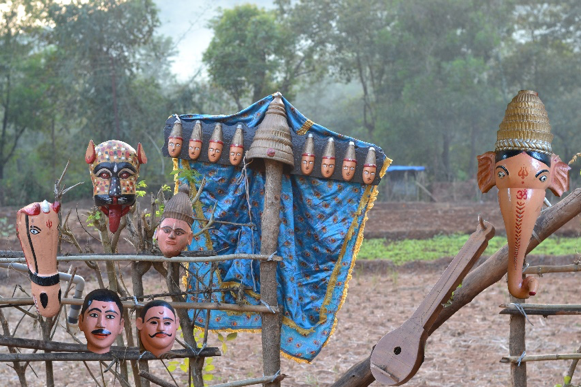
Khele is essentially a four-act play. The acts are namely, ganache naman (praise of Lord Ganesha), gavalanicha bhag (part with the female cowherds), vagh (a story with an antagonist and a protagonist) and Ravanacha nach (the closing act where Ravana is defeated).
Ganache naman is the opening act. It begins with a bhajan (religious melody) praising Lord Ganesha. For the year’s first khele, the thap at the village deity’s temple is a part of the Ganache naman. At least two actors from the khele troupe go to the temple for thap. After that, the gavalans pray to Ganesha as he rests on his seat. When the prayer is over, the drama begins. This act is essentially about an asura (demon) who has received superpowers through deceit. Every other god is defeated and, in the end, Ganesha fights with the asura and saves the day.
The next part is the gavalanicha bhag, which is set in Gokul (the village where Krishna grew up). The gavalanicha bhag is most popular among the audience for its elements of romance, comedy and action. The act begins with the dance of six or more gavalans. During the dance, the ecstatic male members of the audience step on to the stage and throw money at the dancers or roll the currency notes and tuck them in the gavalans’ blouses.
After the dance sequence a man dressed as maushi (aunt), a character often used for comic relief in performance art forms in Maharashtra, appears on the stage to talk to the gavalans. As their conversation continues, some characters dressed as villagers enter the scene. This bunch includes Vadkya (a crooked man) who expresses his interest in one of the gavalans. (Fig. 5) The scene that follows is filled with mockery, smart comebacks and hilarious moments. When one of the gavalan says that she is Radha (Krishna’s romantic companion) the villagers disperse and Krishna enters the scene. The couple performs a dance before Krishna leaves to fight Kansa, an evil king who is also his maternal uncle. The gavalanicha bhag concludes with a fight where Balaram and Krishna defeat and kill Kansa.
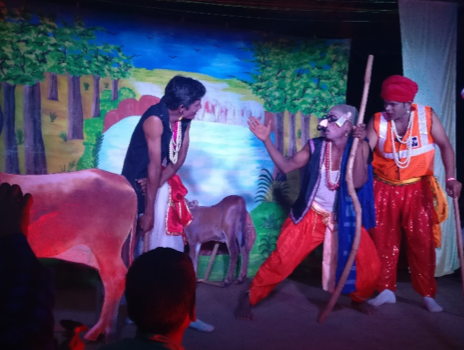
The next act is called vagh, the main act of the show. This is the story of either a king or a leader; there is a protagonist and an antagonist, and it is a fight between the good and the evil. In the end, good triumphs and the show ends with the Ravanacha nach, a dance which is a dramatic metaphor for the victory of good over evil. During the act, Ravana dances with a nine-headed mask, and at the end of the dance he collapses and dies. (Fig. 6)
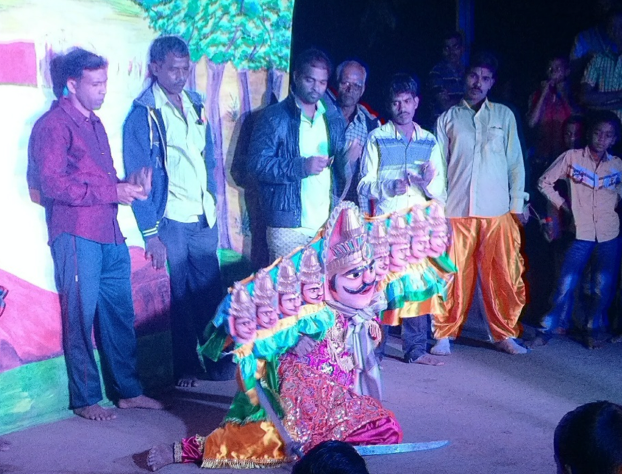
However, khele is primarily known for its association with shigma, i.e. Holi celebrations. Holi is as grand in Konkan as Diwali is along the ghats of the Ganga. In many villages, it is a fortnightly celebration rather than on the single day of Holi Purnima. The celebrations of Holi begin from the fifth day of Phalgun (around March). Every evening, small bonfires are lit in different wadis (neighbourhoods) of the village. On the thirteenth day, a long straight mango trunk is selected from the jungle and axed down for the main Holi bonfire. This trunk is carried by all villagers and taken to the sahan. The Holi fire is lit in the afternoon after the palki (palanquin with deities) is lifted and danced with. (Fig. 7)
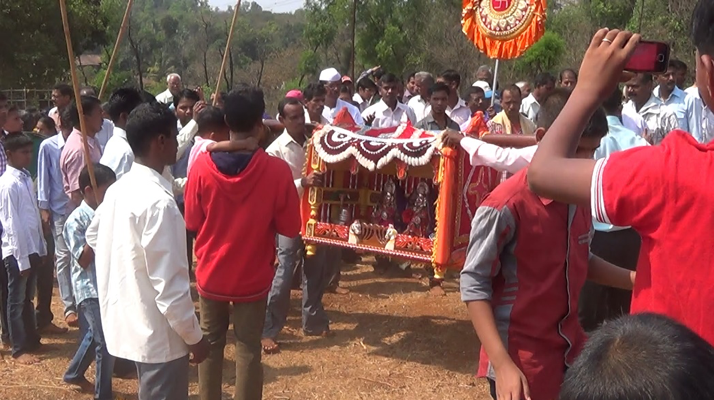
The evening is lit by colourful performances of khele. The villagers practise for months for this performance. They buy costumes from the bazaars of Mumbai and Pune and design backdrops and hire men to manage lights and music. Today, while khele uses dialogues, characters, themes and songs of the past, wooden masks have been replaced by fibre masks, and simple Konkani attires have been replaced by flashy satin costumes. The troupes buy props from the market instead of making them from a scratch, and use thematic backdrops.
The Evolving Nature of the Traditional Art Form
About three decades ago, before the liberalisation of Indian markets in 1991, khele was a simple affair, built with community resources. The sahan would be decorated with strings of colourful paper, and the night performances would take place in the presence of petromax lamps, with freshly carved or repainted wooden masks and colourful blankets or saris, which were the only costumes. Men would dress as Vasudev (the nomad who roams the village singing bhajans in white robes and headgear made of peacock feathers) or wear heavy turbans over simple white shirts and trousers. Every village had their unique dialect and the script was strictly Puranic. The musicians played the cymbals, tabla and ektara. Young boys acting as gavalans would run to their mothers to tie saris. The village carpenter would carve out the masks months before the performance and the local tailor would stitch clothes for the actors.
A lot has changed over the years. It is, however, interesting to note that the expressions, rasas and the tone of the khele performance, even today, takes reference from Bharata Muni’s Natya Shastra, an ancient Sanskrit text on performance arts which was written to direct court performances and has since trickled into folk and local performances across the subcontinent.
Characters in khele are called rupa or songa (representations of the character) who use gestures and words to convey emotions. Although khele does not formally draw from the Natya Shastra, characters as rupaka and the entire play as a game of imitation show some similarities.
The nava rasas (nine aesthetic flavours described as essential for classical Indian arts in Natya Shastra) are also beautifully captured in khele performances. Srungaram (erotic love, romantic love, or as attraction or beauty) rasa can be seen in the gestures, behaviour and makeup of the gavalans. Hasyam (humour) rasa is predominantly seen in the gavalanicha bhag, with the character of Vakdya who morphs his face, bends his body, walks with a limp to accentuate the oddity of his character; his jokes and comebacks alter the temperament of the audience. Raudram (anger and destruction) rasa can be seen during the fight scenes between the gods and demons or the protagonists and antagonists; while in some scenes like the vagh, where the protagonist wins the battle or saves his daughter from the clutches of the antagonist, we may see veeram (heroism) rasa in effect. Bhayanakam (fear) rasa can be experienced from the play of makeup, costumes and lights when asuras enter the stage. Karunyam (empathy and kindness), bibhatsam (disgust) and adbhutam (wonder) rasas are, however, not used frequently. Physical representations of emotions like the head movements to bow and show shame, overconfidence and shyness are all in tune with the Natya Shastra.
The stage and direction also take cues from the Natya Shastra. Kaksha/vibhagan (division of the stage) has been astutely achieved. The khele is performed at the sahan in villages,. There is no separate stage for the performance; a part of the hall is demarcated as the stage and it is covered with multiple layers of curtains which also act as backdrops. A nepatya (green room) is located just at the back of the stage. Props are brought in from the right side of the stage and are removed from the left after the scene, as recommended in Natya Shastra. Even when characters move from one scene to another—as in where the young Krishna rides a horse to go to Kansa’s palace—the horse exits from the left and enters Kansa’s court from right. The entire stage is divided to represent distances. During the gavalanicha bhag, the gavalan and maushi stand close to a river and the three villagers are in fact supposed to be standing far away from them. However, due to the limitation of the size of the stage, they stand nearby but indicate the distance through gestures such as pointing a finger, shading the eyes and squinting. Even with all the new reforms to the art forms, it is interesting to note that the art continues to present itself using the age-old Natya Shastra.
Khele is the art of the people of central Konkan. It is not only their source of entertainment but income as well. Since the art is out in the market as a commodity it has gone through changes to suit the trends of time. The play has become bright and flashy, costume and makeup is loud, and the script now uses the universal dialect of Marathi rather than the local dialect. However, the stories, bhajans and characters have not changed; neither has the place for khele in the hearts of the villagers. Although some artists recollect the old days when, they say, the art was pure, and complain that now it is been infiltrated by Bollywood and Marathi dramas, they also feel that the art has crossed a level and become more universal. Khele is an evolving art of the labour class and a showcase of their altering aspirations.
Bibliography
Ananthakrishnan, B. ‘Pedagogy, Practice and Research in Indian Theatre.’ Theatre Research International 35, no. 3 (2010): 291–92.
Anderson, Leona. 'Religion and Society in Maharashtra.' Edited by Milton Isrel and N.K. Wagle. Studies in Religion/Sciences Religieuses 18, no. 1 (1989): 107.
Chapke, R.R. ‘Traditional Folk Media in Rural Maharashtra—An Analytical Study.’ PhD thesis, Division of Agricultural Extension, Indian Agricultural Research Institute, 2001.
Doshi, S. Maharashtra. Mumbai: Marg Publications, 1985.
Ghosh, Manomohan. The Natyasastra: A Treatise on Hindu Dramaturgy and Histrionics Ascribed to Bharata-muni. Calcutta: The Royal Asiatic Society of Bengal, 1950.
Menon, N., and S. Doshi. The Performing Arts. Mumbai: Marg Publications, 1982.
Ramanujan, A.K. ‘Three Hundred Ramayanas: Five Examples and Three Thoughts on Translation.’ In The Collected Essays of A.K. Ramanujan, edited by V. Dharwadker. Delhi: Oxford University Press, 1999.
Ranade, A.D. Stage Music of Maharashtra. New Delhi: Sangeet Natak Akademi, 1986.
Rege, S. ‘The Hegemonic Appropriation of Sexuality: The Case of The Lavani Performers of Maharashtra.’ Contributions to Indian Sociology 29, no. 1–2 (1995): 23–38.
Sontheimer, Gunther-Dietz, ed. Folk Culture, Folk Religion, and Oral Traditions as a Component in Maharashtrian Culture. New Delhi: Manohar Publishers, 1995.
Tandon, N., ed. Perspectives and Challenges in Indian-English Drama. Delhi: Atlantic Publishers & Distributors, 2006.
